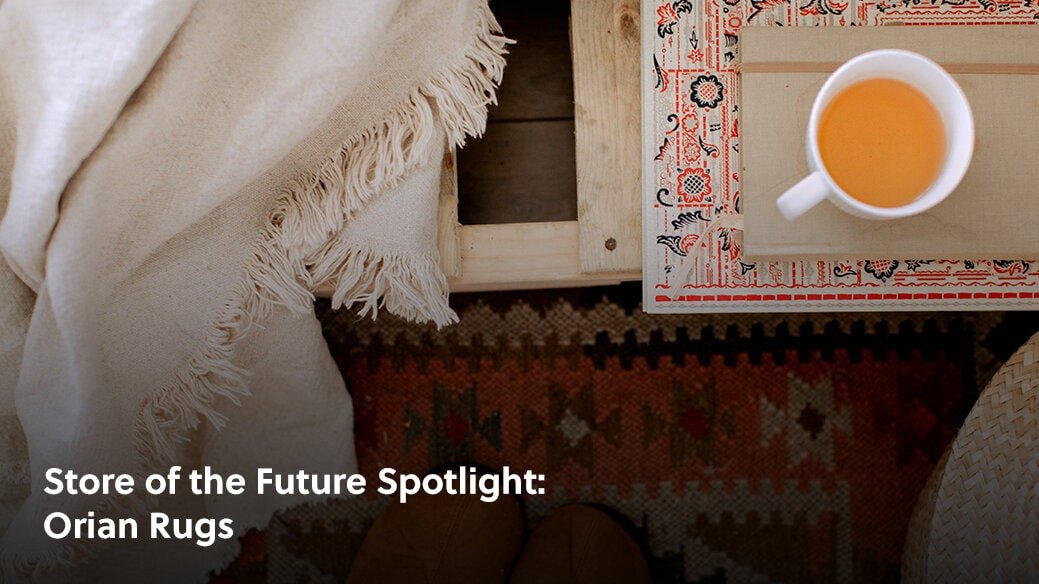Store of the Future Spotlight: Orian Rugs
When it comes to building the store of the future, Orian Rugs knows that it’s essential to adapt to the tides and times. We sat down with Chief Revenue Officer Brandon Culpepper to find out what makes the American-made leader tick in today’s marketplace. His input offers an insider’s look at retaining relevancy in the changing retail landscape.
Q: You recently started updating your product copy and product descriptions for Orian Rugs– can you tell me a little about what led you to make the change?
A: Our marketing is now mainly online, so great photography and copy are mandatory. The right assets must be attached to every item we sell.
Q: How do you define quality product data as it relates to both imagery and supporting copy? And why is it important to a retailer like Orian Rugs?
A: Good quality imagery and copy are obvious . . . poor quality, even more obvious. It takes dedicated, talented professionals to develop good assets. In today’s market, rugs with poor assets to do not sell.
Q: How do you believe quality product data – the description, specifications, imagery and other supporting details – impacts the customer journey?
A: They are as important as the product itself. Consumers shop for rugs, furniture and accessories by lifestyle. The shopper is going for “a look” and the rug is simply part of the lifestyle they are trying to build. The copy and imagery follow an archetype that puts it in play for the look the consumer is trying to create.
Q: With more and more people researching products online before they buy, how do you try to influence or persuade their purchases?
A: Anything we write about our products is important. Good copy is the price of admission . . . however, the long-term success of a product is driven by positive reviews. Consumers are influenced more by what third parties say about rugs than anything we can tell them. Reviews are critical. Trusted influencers and bloggers also play a role.
Q: So, with all companies having equal access to quality product data and influencers, how do you keep Orian Rugs competitive? How do you create a unique value proposition that sets your company apart?
A: We offer the world’s best value in area rugs. You just get way, way more for your money with Orian. Always have and always will. That was as true in 1979 as it is today. The only difference is that technology makes that story easier to tell now than ever before, so we capitalize on digital media to share what sets our company apart.
Q: How long have you been in the home furnishing/home décor industry?
A: Orian has been in business for 40 years. I’ve been doing this for 21.
Q: How did you discover your passion for floor coverings?
A: I started out selling handmade rugs at retail in Dalton, GA. Handmade wool rugs can cost thousands of dollars each, so it requires some knowledge of the product. It’s kind of like selling art . . . the customer needs to know who created it and how they did it. For example, “oriental” rugs are essentially crests that represent families and ethnic groups from places like modern day Iran, Afghanistan, Kazakhstan and Pakistan. These patterns go back thousands of years. Modern rugs are simply watered-down versions of the true art form. Most people who have no idea what they are really looking at when they’re buying a rug, but once I started learning about it, I was hooked.
Q: How have you watched the home decor business change over the last two decades?
A: Weaving and fiber technology has driven costs down and value up. Consumers can now buy beautiful rugs for a fraction of what they would have paid 20 years ago. Also, the shift of retail to catalog showrooms in the 1990’s and then to ecommerce in the 2000’s transferred the inventory burden from retailers to wholesalers. Wholesalers now need to carry massive inventories to support same-day drop shipments. As a manufacturer, we must be well-capitalized product perfectionists . . . as well as distribution experts.
Q: What types of technology (VR/AR, facial recognition, website personalization, apps, etc.) are you most excited about as it applies to retail?
A: AR will be a game-changer. If a consumer can get a real image of what a rug would look like in their home, it will increase sales and cut down returns.
Q: What are you doing to influence the adoption of new technology in your space?
A: We are incorporating some things (like AR) into our showrooms in Atlanta, Las Vegas, High Point, and New York.
Q; What advice would you give to small retailers who want to be competitive against so many big-name competitors swimming in the same pond?
A: Develop a real relationship with your community. As the world becomes more impersonal, people crave contact with authentic people. Be what Amazon and Walmart could never be - authentically connected to the community you aim to serve. Do it in a professional, sophisticated, smart, good-looking and well-merchandised way in your store and online.
Q: What advice would you give 20-year ago Brandon about being competitive in the home furnishings/home décor industry?
A: Believe it or not, when I started in the business, most people in our industry did not believe that rugs would sell online. The thinking was that rugs were bought by touch as much as sight. I would urge my younger self not to fall victim to that line of thinking.

